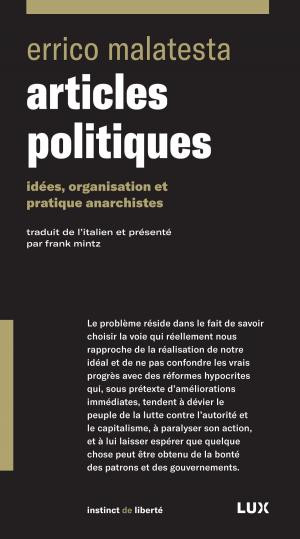R is for Revolution
Nonfiction, History, Revolutionary, Religion & Spirituality, Philosophy, Political| Author: | Patric Hayes | ISBN: | 9781370388424 |
| Publisher: | Patric Hayes | Publication: | January 25, 2017 |
| Imprint: | Smashwords Edition | Language: | English |
| Author: | Patric Hayes |
| ISBN: | 9781370388424 |
| Publisher: | Patric Hayes |
| Publication: | January 25, 2017 |
| Imprint: | Smashwords Edition |
| Language: | English |
R is for Revolution begins by examining the writings of Machiavelli, Erasmus of Rotterdam, and Sir Thomas More. It explores how Guttenberg’s perfection of moveable-type printing, combined with textual analysis led to the Protestant Reformation. Chapter Two discusses how, after Christianity became the official religion of the empire, the Church “lost its way” and became “worldly.” It examines the precursors of Protestantism and discusses the tenants of Protestantism. It ends with a discussion of Luther and Calvin. Chapter three begins with a review of English history from the time of the Romans to the reign of the Stuarts. Following that, comes the story of the Civil War. This necessitates rehearsing the history of the English constitution and Parliament. The chapter ends with a discussion of Hobbes and Locke. The American Revolution treats the colonies’ dispute with Parliament as a recapitulation of Parliament’s struggle with the Stuarts. The chapter begins with an examination of Anglo-Colonial economic relations. It then reviews the milestones on the road to Independence; paying special attention to Thomas Paine. After reviewing the military aspects of the American Revolution, the chapter concludes with a discussion of the writing and adoption of the U.S. Constitution. The story of the French Revolution is told against the back-drop of England’s Civil War and the American Revolution. The chapter discusses the French Enlightenment and examines what transpired between the time Louis XVI summoned the Estates General and Napoleon made himself emperor. Chapter Six discusses Mercantilism and the Physiocrats; it then examines the writings of Adam Smith, Thomas Malthus and David Ricardo. It discusses the Labor theory of Value, the Iron law of Wages, and the Theory of Surplus Value. The chapter ends with a look at utopian and scientific socialism. Chapter Seven studies the ancien regime’s attempt to restore the status quo antebellum following Napoleon’s defeat. Topics discussed include: Prince Metternich and the Congress of Vienna; Tsar Alexander and the Holy Alliance; the Bourbon Restoration, and the July Revolution. Special attention is paid to Metternich’s efforts to suppress Nationalism in Europe, and how his efforts resulted in a series of unsuccessful revolts known as the Springtime of the Peoples. Chapter eight examines how England avoided revolution by prudently reforming its institutions. It examines the effects of the Industrial Revolution, the effort to reform Parliament, and the campaign to repeal the Corn Laws; it ends with a discussion of Utilitarianism and the Chartist Movement. The Russian Revolution shows what happens when reform is thwarted. It begins with Alexander I, and ends with the conclusion of the Russian Civil War. In between, it discusses the Intelligencia, the Narodniks, and the Nihilists. C is for Counter-Revolution attempts to answer the question, “How did it happen?” That is, “How did it come about that the forces of tyranny triumphed over the forces of democracy in 1930s Germany. To answer that question, the chapter looks at the failures of the Weimar Republic, the ideology of fascism and National Socialism, and the political career of Adolf Hitler. The Chinese Revolution tells the story of how the Qing dynasty failed to retain the Mandate of Heaven and how a handful of Chinese visionaries undertook the task of turning China a modern nation. Enroute, such events as the Opium Wars, the Taiping Rebellion and Boxer Rebellion are discussed. Special attention is paid to Mao’s struggle with the “Bolsheviks” and his Sinification of Marxism. The chapter concludes by telling how the Sino-Japanese War morphed in the CBI theater of operations and how Chiang, in spite of having U.S. backing, blew it all an, lost the Civil War to the Communists.
R is for Revolution begins by examining the writings of Machiavelli, Erasmus of Rotterdam, and Sir Thomas More. It explores how Guttenberg’s perfection of moveable-type printing, combined with textual analysis led to the Protestant Reformation. Chapter Two discusses how, after Christianity became the official religion of the empire, the Church “lost its way” and became “worldly.” It examines the precursors of Protestantism and discusses the tenants of Protestantism. It ends with a discussion of Luther and Calvin. Chapter three begins with a review of English history from the time of the Romans to the reign of the Stuarts. Following that, comes the story of the Civil War. This necessitates rehearsing the history of the English constitution and Parliament. The chapter ends with a discussion of Hobbes and Locke. The American Revolution treats the colonies’ dispute with Parliament as a recapitulation of Parliament’s struggle with the Stuarts. The chapter begins with an examination of Anglo-Colonial economic relations. It then reviews the milestones on the road to Independence; paying special attention to Thomas Paine. After reviewing the military aspects of the American Revolution, the chapter concludes with a discussion of the writing and adoption of the U.S. Constitution. The story of the French Revolution is told against the back-drop of England’s Civil War and the American Revolution. The chapter discusses the French Enlightenment and examines what transpired between the time Louis XVI summoned the Estates General and Napoleon made himself emperor. Chapter Six discusses Mercantilism and the Physiocrats; it then examines the writings of Adam Smith, Thomas Malthus and David Ricardo. It discusses the Labor theory of Value, the Iron law of Wages, and the Theory of Surplus Value. The chapter ends with a look at utopian and scientific socialism. Chapter Seven studies the ancien regime’s attempt to restore the status quo antebellum following Napoleon’s defeat. Topics discussed include: Prince Metternich and the Congress of Vienna; Tsar Alexander and the Holy Alliance; the Bourbon Restoration, and the July Revolution. Special attention is paid to Metternich’s efforts to suppress Nationalism in Europe, and how his efforts resulted in a series of unsuccessful revolts known as the Springtime of the Peoples. Chapter eight examines how England avoided revolution by prudently reforming its institutions. It examines the effects of the Industrial Revolution, the effort to reform Parliament, and the campaign to repeal the Corn Laws; it ends with a discussion of Utilitarianism and the Chartist Movement. The Russian Revolution shows what happens when reform is thwarted. It begins with Alexander I, and ends with the conclusion of the Russian Civil War. In between, it discusses the Intelligencia, the Narodniks, and the Nihilists. C is for Counter-Revolution attempts to answer the question, “How did it happen?” That is, “How did it come about that the forces of tyranny triumphed over the forces of democracy in 1930s Germany. To answer that question, the chapter looks at the failures of the Weimar Republic, the ideology of fascism and National Socialism, and the political career of Adolf Hitler. The Chinese Revolution tells the story of how the Qing dynasty failed to retain the Mandate of Heaven and how a handful of Chinese visionaries undertook the task of turning China a modern nation. Enroute, such events as the Opium Wars, the Taiping Rebellion and Boxer Rebellion are discussed. Special attention is paid to Mao’s struggle with the “Bolsheviks” and his Sinification of Marxism. The chapter concludes by telling how the Sino-Japanese War morphed in the CBI theater of operations and how Chiang, in spite of having U.S. backing, blew it all an, lost the Civil War to the Communists.















